Battle of Long Island August 27-29, 1776
 by, Wendy Elkis Girnis, Class of 1977
by, Wendy Elkis Girnis, Class of 1977
The vote for the Declaration of Independence took place on July 2nd of 1776. All of the Colonies voted “Yes” except one. New York abstained for 9 days because they had not received instructions from their assembly on how to vote. Because of this, the first printing of the Declaration, the Dunlap Broadside,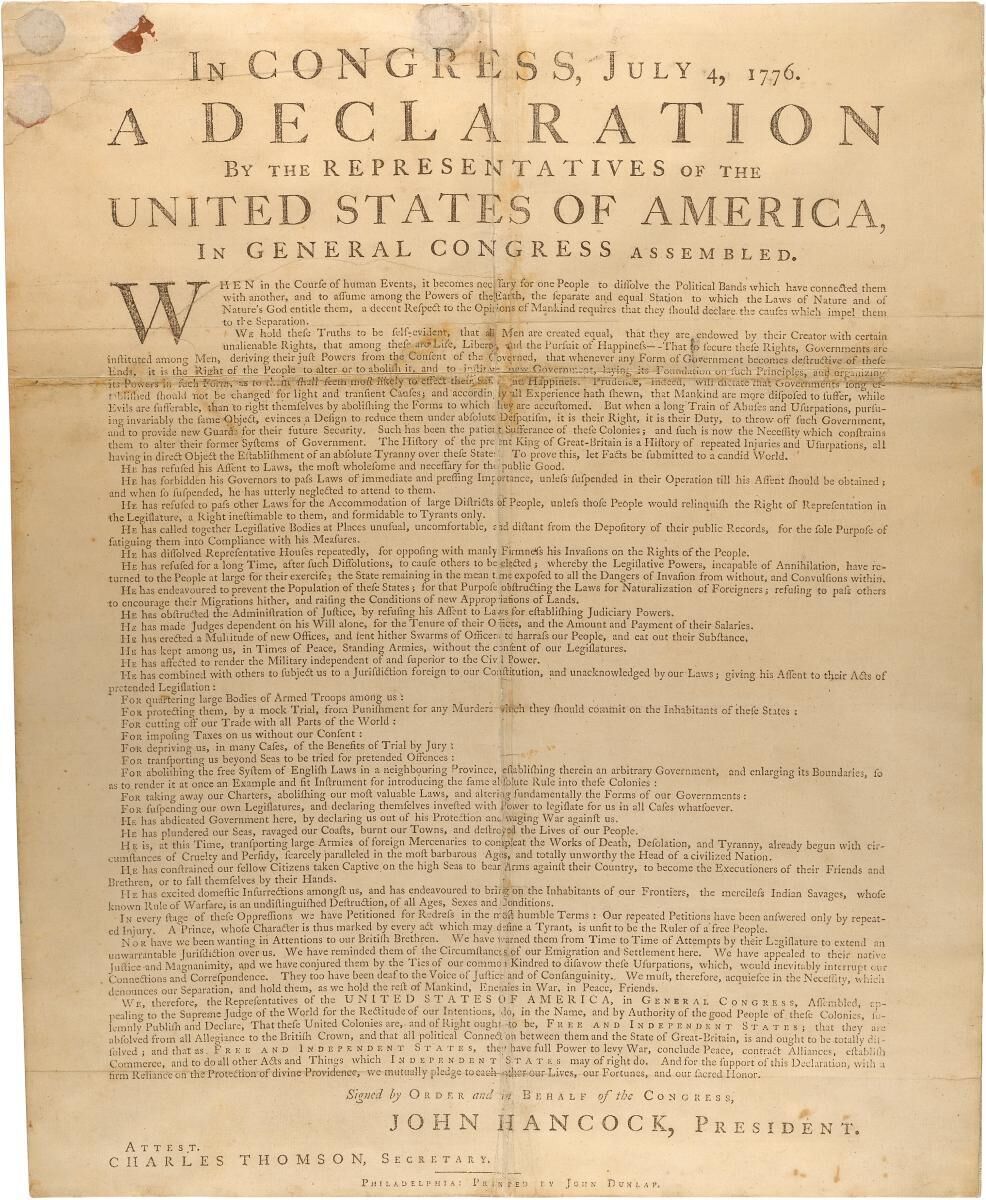 Dunlap Broadside Copy of Declaration
Dunlap Broadside Copy of Declaration 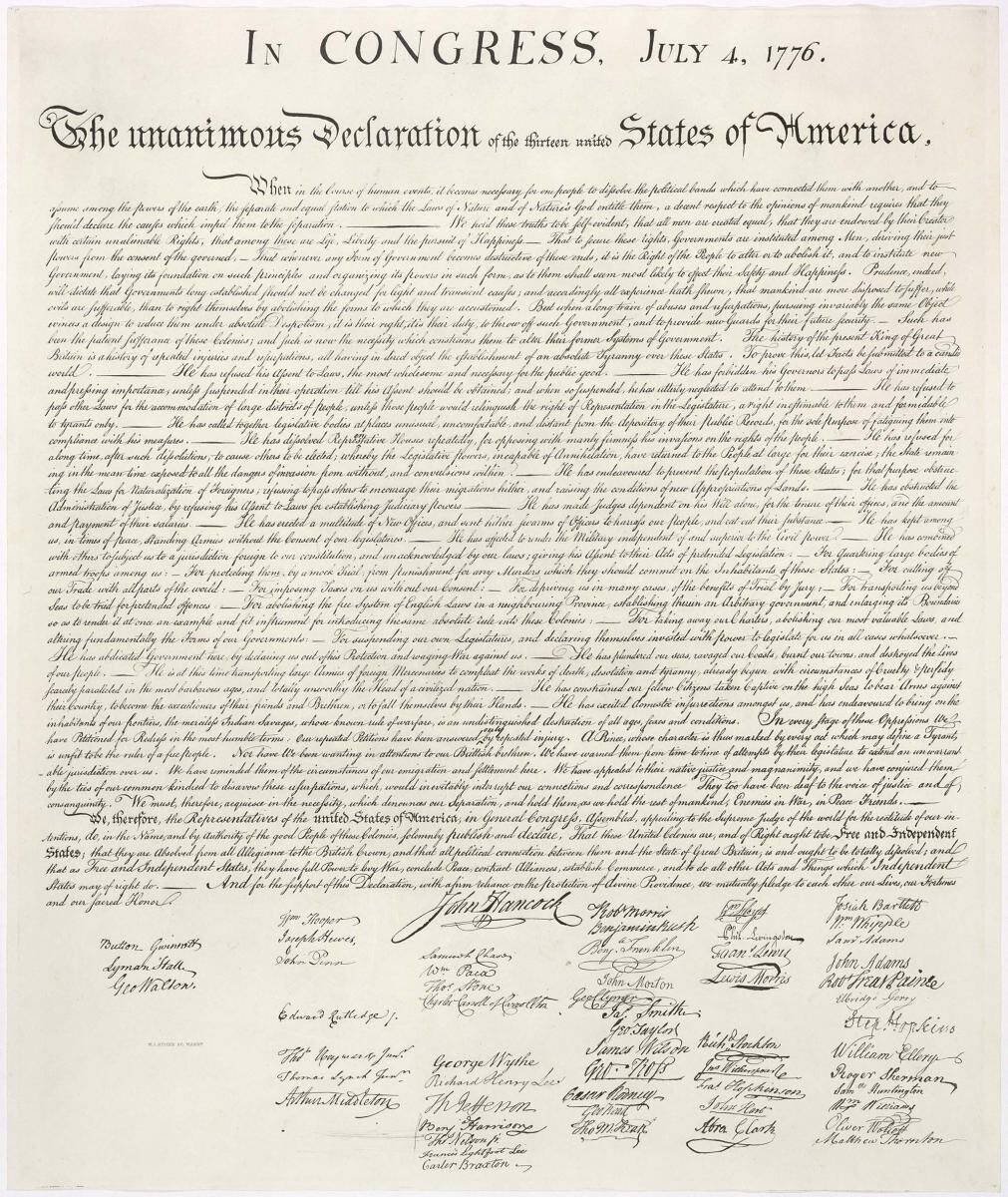 Stone Engraving of the Declaration that says Unanimous Declarationdoes not say “The Unanimous Declaration of...” Fortunately, New York returned with a “Yes” vote, making the vote for Independence unanimous. The first and largest major battle of the Revolutionary War occurred from August 27-29, 1776, in the southwest portion of Long Island, known as Brooklyn Heights.
Stone Engraving of the Declaration that says Unanimous Declarationdoes not say “The Unanimous Declaration of...” Fortunately, New York returned with a “Yes” vote, making the vote for Independence unanimous. The first and largest major battle of the Revolutionary War occurred from August 27-29, 1776, in the southwest portion of Long Island, known as Brooklyn Heights.
The Battle
After the Siege of Boston on March 17, 1776, the British decided to seize control of the strategic Port of New York to isolate New England. British General Lord William Howe, under the protection of the British fleet, moved to occupy New York. With British soldiers arriving, Washington stationed one-third of his troops on Long Island and erected fortifications in Brooklyn Heights. Those fortifications were occupied by Major General Nathanial Green and his men.
As for the British, Howe was encamped on Staten Island with 30,000 British soldiers and Hessian mercenaries. They attacked the south beaches of Long Island on August 22, 1776. The Americans had 9,000 men. Unfortunately, just before the attack, General Green became ill. He was replaced by Major 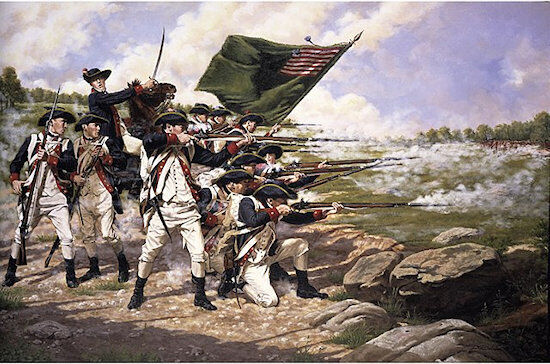 Battle of Long Island, Delaware 1st RegimentGeneral Israel Putnam who was not as capable. Putnam had 6,500 men in the primary position; the rest were placed to block the three roads leading to the Heights.
Battle of Long Island, Delaware 1st RegimentGeneral Israel Putnam who was not as capable. Putnam had 6,500 men in the primary position; the rest were placed to block the three roads leading to the Heights.
British troops were divided into three assault groups by General Howe, one group for each road. After midnight on August 27, Howe’s central and left columns marched forward. Putnam pulled troops to deal with the British threat, leaving the right road undefended. The Americans were outnumbered and needed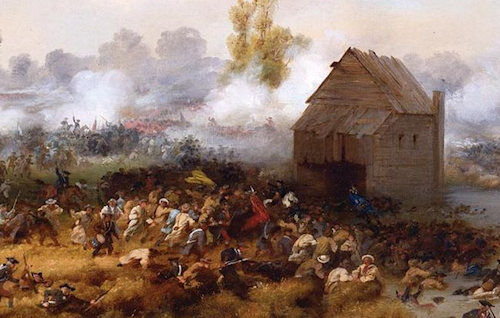 Battle of Long Island Maryland Regiment to retreat to the main defense line. The first Maryland regiment allowed hundreds of Americans to escape the defenses at Brooklyn Heights.
Battle of Long Island Maryland Regiment to retreat to the main defense line. The first Maryland regiment allowed hundreds of Americans to escape the defenses at Brooklyn Heights.
The Retreat
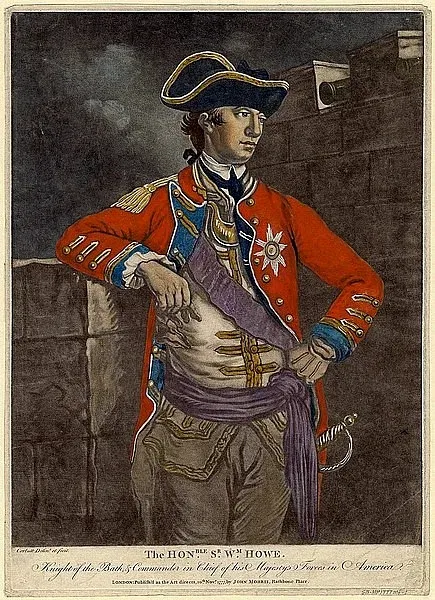 General HoweHowe was successful in his campaign and paused for two days to prepare for a final assault. While waiting, a storm moved in, bringing rain and fog. This forced the British Warships to move downriver. Washington used this opportunity to abandon
General HoweHowe was successful in his campaign and paused for two days to prepare for a final assault. While waiting, a storm moved in, bringing rain and fog. This forced the British Warships to move downriver. Washington used this opportunity to abandon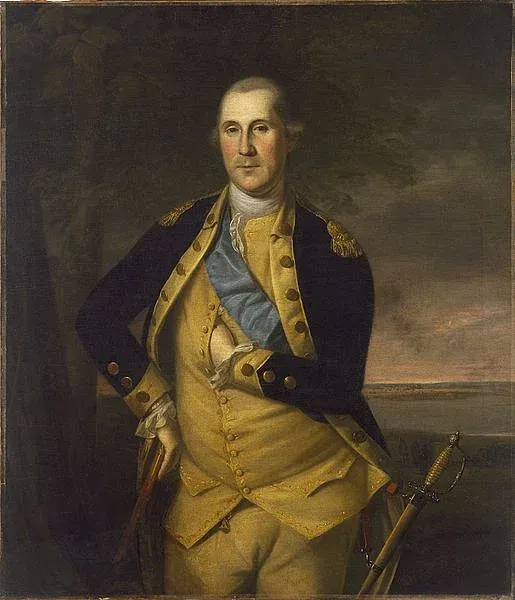 General George Washington 1776 Long Island.
General George Washington 1776 Long Island.
During the Evening of August 29, 1776, the Americans successfully escaped. Washington waited until all his men left, making him the last Continental soldier to leave Long Island. By September 15, Washington finally withdrew to New Jersey. In the end, American losses/casualties were 300 dead, 650–800 wounded, and 1,100 captured; British and German losses / casualties were 64 dead, 314 wounded, missing, or captured. The British held New York for the rest of the war.
Afterwards
Washington faced General Howe eight times in the 15 battles his army fought. Of those engagements with Howe, he lost six times. Luckily, the tide turned, and the Americans won the war. The Treaty of Paris was signed in 1783. In May of 1787, Washington called for the (Constitutional) Convention. The US Constitution was completed on September 17, 1787.
During the debate about the Executive Branch, the Antifederalists were worried that the President would be an elected monarch who would develop small groups of secret plotters that would go against the government. They worried that the pardon power and the veto power would be abused. Federalists argued that the President would only enforce laws and conduct foreign policy. Unlike the King, the President would have the other two branches, Judicial and Legislative, as checks on his power. Although Washington desired to retire, he ran for President because he felt it was his duty to serve his country.
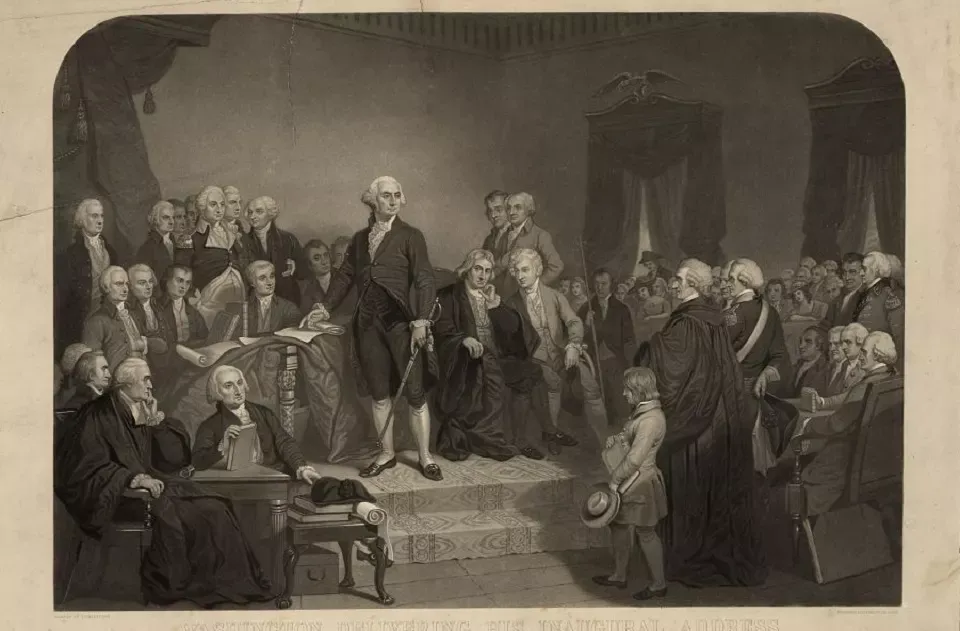 An 1849 print by Henry Sadd & John Neale, based on a painting by T. H. Matteson, depicting George Washington's first inauguration on April 30, 1789. Library of Congress
An 1849 print by Henry Sadd & John Neale, based on a painting by T. H. Matteson, depicting George Washington's first inauguration on April 30, 1789. Library of Congress
During his two terms, Washington had the trust and admiration of the American people. They knew that they could trust him not to take advantage of the power of the president. He worked to be a president for all, which at the time meant white men. He was mindful of the principles of republican virtue. Self-sacrifice, decorum, self-improvement, and leadership were what he strived for. Our expectations of presidents today, that they should be held to higher standards and that the office carries a certain level of respect and prestige, began with Washington’s careful creation of the position. Washington also left his mark on the political process by choosing a cabinet, a group of carefully selected people who would help him make decisions.
Washington retired from the presidency after two terms, setting a precedence for all future presidents until FDR. Washington was worried about the power the president might accrue if they served more than two terms. He knew that Americans needed to learn how to elect, transition, and inaugurate a new president for our country to be successful. Washington wanted this process to be planned out and not haphazard. After FDR, the 22nd Amendment was added, giving the office of the president a two-term limit.
Although our country admires and reveres Washington, we can't help but remind ourselves that he did have enslaved people. He pursued those who had escaped instead of letting them go free. During Washington's time, his wealth and lifestyle depended on enslaved people. Although he didn't free his enslaved people while alive, by the end of his life, he knew the institution was wrong and freed his slaves after his death. When his will was made public, it sent a shockwave through the country. By freeing his enslaved people, he made a statement about the morality of slavery, albeit a little too late.
History may not always be pretty, but it has made us who we are today. History reminds us of not just what we have done well but also what mistakes we've made so we can correct them. Looking at all sides of history gives us a 360-degree view of our lives. As I would tell my students, you need to look at all sides of the story and listen to all points of view. Somewhere in all of it is the truth. You have to have an open mind, do your own analysis, listen, and come to a logical conclusion.
Resources
- Britannica - Battle of Long Island, American history [1776] https://www.britannica.com/event/Battle-of-Long-Island
- Ducksters- The Battle of Long Island https://www.ducksters.com/history/american_revolution/battle_of_long_island.php
- World History Enclyclopedia - Battle of Long Island https://www.worldhistory.org/article/2359/battle-of-long-island/
- Center for the Study of the American Constitution- The Debate over the President and the Executive Branch https://csac.history.wisc.edu/document-collections/constitutional-debates/executive-branch/
Illustrations:
- Dunlap Printed Copy of Declaration- https://www.archives.gov/publications/prologue/2016/fall/declaration
- Matlack Handwritten Copy of Declaration- https://www.archives.gov/publications/prologue/2016/fall/declaration
- Battle of Long Island - https://www.ducksters.com/history/american_revolution/battle_of_long_island.php
- The Maryland 400 - https://www.ducksters.com/history/american_revolution/battle_of_long_island.php
- The Retreat - https://www.ducksters.com/history/american_revolution/battle_of_long_island.ph
- George Washington - https://www.worldhistory.org/article/2359/battle-of-long-island/
- General Howe - https://www.worldhistory.org/article/2359/battle-of-long-island/
- Washington's Legacy https://millercenter.org/president/washington/impact-and-legacy
- An 1849 print by Henry Sadd and John Neale, based on a painting by T. H. Matteson, depicting George Washington's first inauguration on April 30, 1789. Library of Congress https://www.nps.gov/articles/000/george-washington-inauguration.htm

